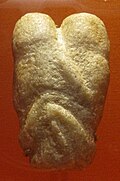Mesolithic
Mesolithic is a period in the development of human technology that is traditionally considered the middle part of the Stone Age. The broad period lasted from 15,000 to 5,000 BC. The term "Mesolithic" is used to describe sites falling between the Paleolithic and the Neolithic periods. While the start and end dates of the Mesolithic period vary by geographical region, the culture and technology of Mesolithic societies is distinct.
Overview[edit]
The Mesolithic period represents a transitional phase between the hunter-gatherer cultures of the Paleolithic period and the farming cultures of the Neolithic period. During the Mesolithic period, humans developed an increasingly sophisticated understanding of their environment and learned to manipulate it to their advantage. This period is characterized by the development of microliths, small stone tools that were part of more complex tools and weapons, and the increasing reliance on a broader range of plant and animal resources than in the Paleolithic period.
Regional Variations[edit]
The Mesolithic period is not universally recognized, and in many regions, this period is either not used or is replaced by regional terms. For example, in the New World, the term "Archaic period" is more commonly used, while in much of Asia, the term "Epipaleolithic" is often used.
See Also[edit]
References[edit]
<references />
|
|
|
-
Hunter gatherer's camp at Irish National Heritage Park
-
Evolution of temperature in the Post-Glacial period according to Greenland ice cores
-
Opgraving Stevoort
-
Большой шигирский идол
-
Sépulture de Teviec Global
-
Lovers 9000BC British Museum
-
Star Carr Engraved Pendant
-
Pintures de la cova dels Moros, exposició al Museu de Gavà
-
National Museum of China
-
Comb Ceramic Culture
Ad. Transform your life with W8MD's Budget GLP-1 injections from $75


W8MD offers a medical weight loss program to lose weight in Philadelphia. Our physician-supervised medical weight loss provides:
- Weight loss injections in NYC (generic and brand names):
- Zepbound / Mounjaro, Wegovy / Ozempic, Saxenda
- Most insurances accepted or discounted self-pay rates. We will obtain insurance prior authorizations if needed.
- Generic GLP1 weight loss injections from $75 for the starting dose.
- Also offer prescription weight loss medications including Phentermine, Qsymia, Diethylpropion, Contrave etc.
NYC weight loss doctor appointmentsNYC weight loss doctor appointments
Start your NYC weight loss journey today at our NYC medical weight loss and Philadelphia medical weight loss clinics.
- Call 718-946-5500 to lose weight in NYC or for medical weight loss in Philadelphia 215-676-2334.
- Tags:NYC medical weight loss, Philadelphia lose weight Zepbound NYC, Budget GLP1 weight loss injections, Wegovy Philadelphia, Wegovy NYC, Philadelphia medical weight loss, Brookly weight loss and Wegovy NYC
|
WikiMD's Wellness Encyclopedia |
| Let Food Be Thy Medicine Medicine Thy Food - Hippocrates |
Medical Disclaimer: WikiMD is not a substitute for professional medical advice. The information on WikiMD is provided as an information resource only, may be incorrect, outdated or misleading, and is not to be used or relied on for any diagnostic or treatment purposes. Please consult your health care provider before making any healthcare decisions or for guidance about a specific medical condition. WikiMD expressly disclaims responsibility, and shall have no liability, for any damages, loss, injury, or liability whatsoever suffered as a result of your reliance on the information contained in this site. By visiting this site you agree to the foregoing terms and conditions, which may from time to time be changed or supplemented by WikiMD. If you do not agree to the foregoing terms and conditions, you should not enter or use this site. See full disclaimer.
Credits:Most images are courtesy of Wikimedia commons, and templates, categories Wikipedia, licensed under CC BY SA or similar.
Translate this page: - East Asian
中文,
日本,
한국어,
South Asian
हिन्दी,
தமிழ்,
తెలుగు,
Urdu,
ಕನ್ನಡ,
Southeast Asian
Indonesian,
Vietnamese,
Thai,
မြန်မာဘာသာ,
বাংলা
European
español,
Deutsch,
français,
Greek,
português do Brasil,
polski,
română,
русский,
Nederlands,
norsk,
svenska,
suomi,
Italian
Middle Eastern & African
عربى,
Turkish,
Persian,
Hebrew,
Afrikaans,
isiZulu,
Kiswahili,
Other
Bulgarian,
Hungarian,
Czech,
Swedish,
മലയാളം,
मराठी,
ਪੰਜਾਬੀ,
ગુજરાતી,
Portuguese,
Ukrainian










